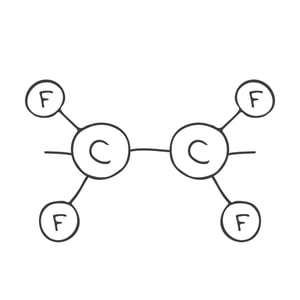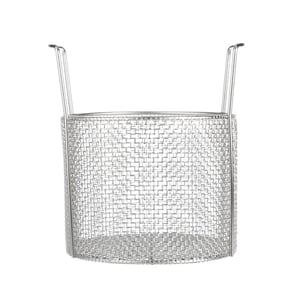 Sanitation is an enormous concern in the food industry. Every year, cases of food poisoning and food-borne illness make headlines and cause near-irreparable harm to the companies linked to such incidents.
Sanitation is an enormous concern in the food industry. Every year, cases of food poisoning and food-borne illness make headlines and cause near-irreparable harm to the companies linked to such incidents.
To minimize risk of contamination, food production equipment needs to follow some key guidelines for:
- Its ability to be cleaned/sanitized
- Accessibility for inspection
- Preventing the collection of product or liquid
- Prevent harborage/growth of bacteria
These guidelines apply to every piece of equipment used to process food—not just big items like mixers and ovens, but the very containers used to hold and move food between processes.
In many applications, it’s necessary to use a specialized coating on steel baskets to better protect the basket and the food on it. However, not just any coating will do for any basket and process.
To follow the principles of sanitary design, the metal coatings you use have to be carefully selected. Which metal coatings are right for your process?
The answer will depend on a few key factors, such as your process and the kinds of ingredients the coatings will come into contact with. With this in mind, here’s a list of some of the more common food safe metal coatings and finishes:
Food Safe Metal Coating #1: Polytetrafluoroethylene (Teflon®)
 Odds are that you’re familiar with the Chemours-owned brand name coating known as Teflon®.
Odds are that you’re familiar with the Chemours-owned brand name coating known as Teflon®.
As a hydrophobic material, Polytetrafluoroethylene (PTFE) resists the absorption of water and other liquids with oxygen and hydroxyl compounds. Additionally, PTFE is famous for its low coefficient of friction, which is why it is often used as a nonstick coating for cooking.
With a continuous use temperature threshold of 500°F (260°C), PTFE polymer coatings are ideal for use in high-temperature processes.
PTFE is a very popular coating for the food industry, and for good reason. However, it’s important to note that there are some applications that PTFE might not be good for.
While PTFE has a very strong chemical resistance, the coating tends to be very thin and porous, so the underlying metal may still be exposed to chemical corrosion if the basket is submerged in acidic chemicals (such as tomato & lemon juices).
Food Safe Metal Coating #2: Fluorinated Ethylene Propylene (FEP)
Fluorinated Ethylene Propylene, or FEP, shares many characteristics with PTFE, and is another polymer under the Chemours Teflon® brand name.
Like PTFE, FEP is hydrophobic, resisting water in liquid and gaseous form. Chemours’ brief on FEP notes that, “FEP film is chemically inert and resistant to virtually all chemicals, except molten alkali metals, gaseous fluorine, and certain complex halogenated compounds, such as chlorine trifluoride at elevated temperatures and pressures.”
FEP does have a lower continuous use temperature than PTFE—the maximum recommended temperature for FEP is 400°F (205°C), and the material will melt at temperatures above 500°F (260°C). This makes FEP slightly less suitable for use in ovens and other high-temperature processes.
Food Safe Metal Coating #3: Electropolishing Steel
 Technically, this isn't a food grade coating for metal, but rather a type of finishing process for food safe steel. In many instances, rather than using a coating, food manufacturers will use uncoated metal that has been specially finished to enhance smoothness and resistance to corrosion.
Technically, this isn't a food grade coating for metal, but rather a type of finishing process for food safe steel. In many instances, rather than using a coating, food manufacturers will use uncoated metal that has been specially finished to enhance smoothness and resistance to corrosion.
Electropolishing is a common treatment for stainless steel in the food industry. The process leaves the surface of the steel microscopically smooth and enhances corrosion resistance. It's also used as a substitute for a food safe metal coating for aluminum, since the material is already highly safe for food.
A key benefit of electropolishing steel is that it makes it easier to sanitize, and removes the microscopic flaws that could allow bacteria to become embedded in the steel’s surface.
The only major drawback is that this does not create a coating that will significantly protect the base metal from particularly harsh chemicals. To offset this, many electropolished food baskets are made of stainless steel that is already resistant to oxidation.
Food Safe Metal Coating #4: Antimicrobial Coatings
There are a wide variety of antimicrobial coatings available on the market, each with different performance characteristics in regards to temperature tolerance, chemical resistance, surface hardness, and tensile strength.
Antimicrobial coatings are best known for their ability to fight the spread of bacteria on their surface. There are two general ways that these coatings work:
- Active Coatings. These coatings have an active ingredient that is consumed to kill bacteria. Silver powder is a common active ingredient that damages bacteria’s DNA to keep it from multiplying successfully.
- Passive Coatings. Rather than killing bacteria, these coatings use special surface characteristics to prevent microbes from adhering to the surface or to physically damage the cell walls of bacteria.
Active coatings tend to be more effective at killing bacteria, but must be periodically reapplied as their active ingredients are consumed. Passive coatings tend to last longer, which can lower their total cost of ownership.
However, even with an antimicrobial coating for food grade metal, it's important to practice consistent hygiene for any coated surfaces that come into contact with food. Any such surfaces should be routinely cleaned and sanitized per FDA requirements, and kept free of contaminants as much as possible to prevent food contamination.
Do Food Safe Metals Need Food Grade Coatings?
One common misconception about food safe metals such as aluminum or grade 430 stainless steel is that they don't really need a food grade metal coating. After all, these metals are already oxidation resistant, tougher than most polymer coatings, and easy to clean. So, why would you need a special coating or food-safe finish?
Part of the reason why you should use food grade coatings on food safe metals is that, although these metals are tough, the use of a coating can help to extend their useful life further—helping to reduce your total cost of ownership (TCO) for any trays, baskets, or other custom wire forms the coating is applied to.
For example, say your food manufacturing process involves the use of salt—whether it's a seasoning, preservative, or incidental byproduct. Even highly resistant grade 316 stainless steel (which is noted for its resistance to chlorides), may experience some pitting if exposed to enough salt or salt-enriched fluids over a long period of time.
By applying even a thin coating of material, you can leverage the tensile strength of the steel while protecting it from direct contact with the salt. When the coating wears thin, it can be reapplied for a fraction of the cost of buying a whole new basket or tray—helping you minimize your TCO for your food processing equipment.
Which Coating is Best for You?
By comparing the characteristics of each type of coating to your food production processes, you should be able to identify the type of food grade coating or surface finish that is right for you.
If you have high temperature processes, such as oven-based cooking, then a high-temperature polymer such as PTFE might be suitable—or electropolishing might work if temperatures exceed PTFE’s limits.
If bacteriological contamination is a concern, an antimicrobial coating might be best.
Ultimately, choosing the right coating will take careful consideration. Find out more about food safe metal coatings and surface treatments today!



.gif)


